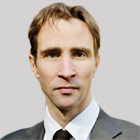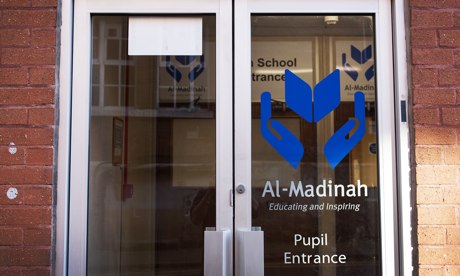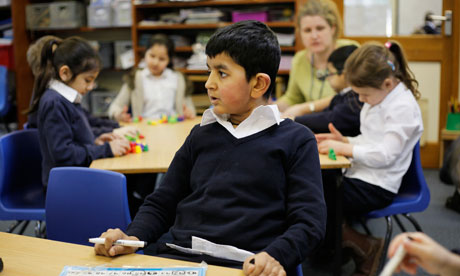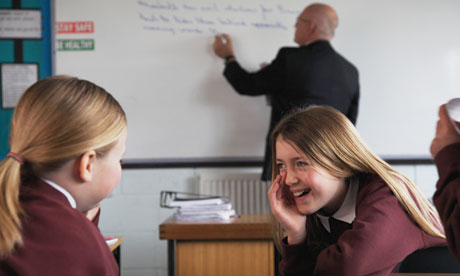Education in brief: free school governor criticises entire policy
School's
closure prompts angry letter to academies minister; community schools
miss out on honours; Will Straw campaigns for parent power, and still no
news of changes to primary assessment
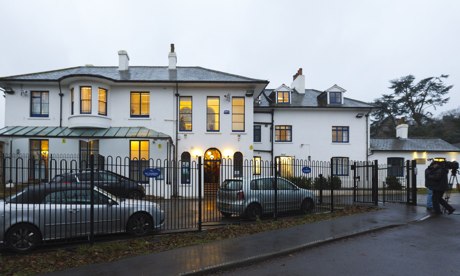
Discovery New school in Crawley, West Sussex: did the media know about its closure before the school? Photograph: Chris Ison/PA
Governor hits out at free school policy
The chair of governors at a free school whose closure was announced by ministers last month has launched a fierce attack on the government, remarkably branding the free schools policy itself as "rushed and ill-considered".
In a letter to the academies minister, Lord Nash, Chris Cook, chair of governors at Discovery New school in Crawley, West Sussex, also hit out at the education department for, he alleges, tipping the media off about its closure before the school found out and giving the school "no detailed advice" on how it should go about closing itself down.
In the letter, Cook says: "As chair of governors I was disappointed that your letter of 13 December [announcing the closure] was released to the press and knowledge of its release was available before the school was informed.
"This action demonstrated a complete disregard for the wellbeing of the children, parents and staff." Cook says Nash's letter was made public as parents were preparing to watch their children in a nativity play, with some parents and staff then leaving the school by a back entrance as reporters descended.
He tells Nash: "We sense that you are prepared to wash your hands and crucify the school rather than engage in a proper consideration of our plans because it is easier to make [us] the scapegoat for being an early adopter of a free school policy which the National Audit Office has rightly criticised for being rushed and ill-considered."
It adds that the school's original set-up, which saw its founding husband-and-wife team given jobs as school business director and principal respectively and their daughter serving as a teacher-governor, had been approved by the DfE.
The letter calls on ministers to reconsider. But this seems unlikely.
The DfE says Cook had been sent Nash's letter, and informed by phone some 70 minutes before any press knew about the closure. "We will not hesitate to intervene and take swift action if children are being denied the education they deserve," says the spokesman.
Community schools lose out on honours
Few would begrudge the recognition given to those who received honours for longstanding services to education in last week's New Year list. But does the make-up of the list itself say something about the government's preferences for schools reform?
Looking at the backgrounds of those made knights and dames, the DfE-backed academies movement is heavily represented, with those from community schools barely registering. In fact, of the seven new dames and knights with close connections to schools, six are or have been heads of academies or are an academy sponsor, while only one – Sir Craig Tunstall, executive head of the Gipsy Hill federation in south London – currently leads or teaches in the non-academy sector.
A further 17 people from academies received CBEs, OBEs, MBEs or the British Empire Medal for their work, compared with 15 from state-funded non-academy schools. Yet academies make up only one in six of England's 21,000 state-funded schools.
It could be that academies are attracting above their fair share of dynamic individuals who are worthy of recognition. But Jane Eades, of the Anti Academies Alliance, who compiled some of the figures above, says: "There seems to be very little recognition for outstanding heads and chairs of governors of community schools. Is this because they are just taken for granted by their school communities and their names not put forward for recognition, or is their nomination not being approved?" Interesting question.
Will Straw campaigns for parent power
A new year dawns with more campaigns to stop schools being forced to become academies against their communities' wishes. In Barking and Dagenham, east London, councillors have unanimously voted to urge any school that is about to convert to academy status to ballot parents on the plans, giving them the "final say".
The move comes after governors at Dorothy Barley junior school in Dagenham were replaced by an "interim executive board" (IEB) appointed by Michael Gove, the education secretary, with a brief formally to consult on the school becoming a sponsored academy.
Schools have sometimes been forced into academy status despite seemingly overwhelming parental opposition, and the National Union of Teachers points out that Dorothy Barley's five-member interim board includes two chairs of governors from schools already run by the prospective academy's sponsor.
Meanwhile, in Darwen, Lancashire, more than 1,600 people have signed a petition , organised by Will Straw, the local Labour parliamentary candidate, asking for parents, pupils and staff to be given a choice over who runs Darwen Vale high when it becomes an academy.
This comes after the DfE lined up the Aldridge Foundation, an academy trust set up by the founder of outsourcing firm Capita, as sponsor of the school, which failed an Ofsted inspection in June. Campaigners are particularly unhappy as the foundation runs the town's only other secondary.
Straw (pictured), says: "Essentially the DfE are trying to impose the Aldridge Foundation on the school without consultation with parents, teachers or children."
But will the campaigners be listened to? Given the DfE's record, we wonder if another interim board may be around the corner. A DfE spokesman says: "The Aldridge Foundation is our preferred sponsor for Darwen Vale due to its excellent track record in similar schools. However, no final decisions have been taken."
Primary assessment – why are we waiting?
And finally, we are still waiting for news as to when the government will respond to the consultation on controversial plans for the reform of primary assessment and accountability, including the public ranking of pupils into 10 "deciles". The consultation finished in October, but there is still no word on when a final response will be published. As reported previously by Speed read, the whisper is that plans to rank pupils into 10 categories in national curriculum tests have died, but that the almost-as-contentious move to introduce baseline assessments for four-year-olds may still be on the cards. When will the policy be finalised, we wonder.
Governor hits out at free school policy
The chair of governors at a free school whose closure was announced by ministers last month has launched a fierce attack on the government, remarkably branding the free schools policy itself as "rushed and ill-considered".
In a letter to the academies minister, Lord Nash, Chris Cook, chair of governors at Discovery New school in Crawley, West Sussex, also hit out at the education department for, he alleges, tipping the media off about its closure before the school found out and giving the school "no detailed advice" on how it should go about closing itself down.
In the letter, Cook says: "As chair of governors I was disappointed that your letter of 13 December [announcing the closure] was released to the press and knowledge of its release was available before the school was informed.
"This action demonstrated a complete disregard for the wellbeing of the children, parents and staff." Cook says Nash's letter was made public as parents were preparing to watch their children in a nativity play, with some parents and staff then leaving the school by a back entrance as reporters descended.
He tells Nash: "We sense that you are prepared to wash your hands and crucify the school rather than engage in a proper consideration of our plans because it is easier to make [us] the scapegoat for being an early adopter of a free school policy which the National Audit Office has rightly criticised for being rushed and ill-considered."
It adds that the school's original set-up, which saw its founding husband-and-wife team given jobs as school business director and principal respectively and their daughter serving as a teacher-governor, had been approved by the DfE.
The letter calls on ministers to reconsider. But this seems unlikely.
The DfE says Cook had been sent Nash's letter, and informed by phone some 70 minutes before any press knew about the closure. "We will not hesitate to intervene and take swift action if children are being denied the education they deserve," says the spokesman.
Community schools lose out on honours
Few would begrudge the recognition given to those who received honours for longstanding services to education in last week's New Year list. But does the make-up of the list itself say something about the government's preferences for schools reform?
Looking at the backgrounds of those made knights and dames, the DfE-backed academies movement is heavily represented, with those from community schools barely registering. In fact, of the seven new dames and knights with close connections to schools, six are or have been heads of academies or are an academy sponsor, while only one – Sir Craig Tunstall, executive head of the Gipsy Hill federation in south London – currently leads or teaches in the non-academy sector.
A further 17 people from academies received CBEs, OBEs, MBEs or the British Empire Medal for their work, compared with 15 from state-funded non-academy schools. Yet academies make up only one in six of England's 21,000 state-funded schools.
It could be that academies are attracting above their fair share of dynamic individuals who are worthy of recognition. But Jane Eades, of the Anti Academies Alliance, who compiled some of the figures above, says: "There seems to be very little recognition for outstanding heads and chairs of governors of community schools. Is this because they are just taken for granted by their school communities and their names not put forward for recognition, or is their nomination not being approved?" Interesting question.
Will Straw campaigns for parent power
A new year dawns with more campaigns to stop schools being forced to become academies against their communities' wishes. In Barking and Dagenham, east London, councillors have unanimously voted to urge any school that is about to convert to academy status to ballot parents on the plans, giving them the "final say".
The move comes after governors at Dorothy Barley junior school in Dagenham were replaced by an "interim executive board" (IEB) appointed by Michael Gove, the education secretary, with a brief formally to consult on the school becoming a sponsored academy.
Schools have sometimes been forced into academy status despite seemingly overwhelming parental opposition, and the National Union of Teachers points out that Dorothy Barley's five-member interim board includes two chairs of governors from schools already run by the prospective academy's sponsor.
Meanwhile, in Darwen, Lancashire, more than 1,600 people have signed a petition , organised by Will Straw, the local Labour parliamentary candidate, asking for parents, pupils and staff to be given a choice over who runs Darwen Vale high when it becomes an academy.
This comes after the DfE lined up the Aldridge Foundation, an academy trust set up by the founder of outsourcing firm Capita, as sponsor of the school, which failed an Ofsted inspection in June. Campaigners are particularly unhappy as the foundation runs the town's only other secondary.
Straw (pictured), says: "Essentially the DfE are trying to impose the Aldridge Foundation on the school without consultation with parents, teachers or children."
But will the campaigners be listened to? Given the DfE's record, we wonder if another interim board may be around the corner. A DfE spokesman says: "The Aldridge Foundation is our preferred sponsor for Darwen Vale due to its excellent track record in similar schools. However, no final decisions have been taken."
Primary assessment – why are we waiting?
And finally, we are still waiting for news as to when the government will respond to the consultation on controversial plans for the reform of primary assessment and accountability, including the public ranking of pupils into 10 "deciles". The consultation finished in October, but there is still no word on when a final response will be published. As reported previously by Speed read, the whisper is that plans to rank pupils into 10 categories in national curriculum tests have died, but that the almost-as-contentious move to introduce baseline assessments for four-year-olds may still be on the cards. When will the policy be finalised, we wonder.
